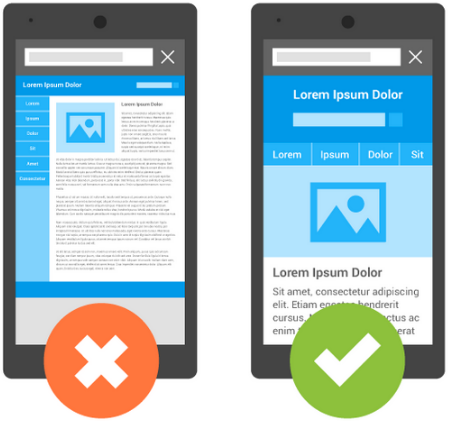Many obstacles in life exist solely to infuriate humankind; picture tangled Christmas lights, traffic jams, and especially slow loading websites. Did you know, slow loading sites cost retailers $2.6 billion in lost sales each year? No wonder CEO's and marketers are focused on providing a positive user experience for people on their websites, and you should be too -- if increasing site traffic is anywhere on your to-do list. Continue reading for the common ways bad user experience is costing your business money.
Let's review what creates a good VS. bad user experience (UX) because the feelings a stranger has towards your website affects how they perceive your product, brands, and services. A positive UX comes from sites that are easy to navigate, designed well, include lots of helpful content, clear avenues of contacting the company, and are optimized across all devices. Like the picture below, your sites needs to be optimized, especially for mobile, since people spend more time than ever searching on their smartphones. If the prospect has to zoom and scroll around your site, like the screen on the left, you're likely to lose their interest and business. If your business website doesn't meet the criteria for a good UX it could cost you in more ways than just low site visits.

1. Making a Bad First Impression
We've said it before, and we'll say it again, most of the people landing on your website are at the top of the funnel, meaning they have never heard of your company or services before and they're not ready to make a buying decision.
Now, if a stranger is landing on your site for the first time, they're gong to make an impression of your company in a few quick seconds. If your site is designed poorly, or not optimized for mobile, you're losing your chance to look reliable to your prospects. When you don't appear like a trustworthy company with a user-friendly site, especially on mobile, people are less likely to buy from you. In fact, 52% of users said a bad mobile experience made them less likely to engage with a company! Failing to design your site so it's aesthetically pleasing and mobile optimized will impact your bottom line.
2. Failing Lead Generation
How long is your sales cycle? Think for a moment how frustrating it is when you don't have sufficient leads to nurture, not reaching your quotas and sales goals. Many marketers struggle with lead generation, according to HubSpot's State of Inbound 2016 Report, 66% of respondents said lead generation was their company's top marketing challenge.
A poor UX will drive potential leads away from your site, negatively impacting your lead generation and sales. Nearly half of web-users will ditch a site of it takes longer than 3 seconds to load; there goes half of your prospective leads, drastically decreasing your chances to convert and close.
Your website should have clear call-to-action areas that guide people to the resources they desire. Without clear navigation and CTA's, strangers could get frustrated trying to find the information they want. In an evaluation of 200 small business websites, 70% of those reviewed didn’t display clear calls-to-action for anything on their home pages, such as webinar specials, email newsletters, how-to guides, demos, and interactive tools. Poorly designing your website and not showcasing your buyer-tailored content means you're missing out on capturing valuable lead information.
3. Missing out on Sales
The trust and experience your website commands significantly affects your sales, especially if your site includes any element of eCommerce. If your site looks out-of-date, if it's not optimized for mobile, slow loading, or has broken links - people's perception of your brand diminishes, and they are less likely to buy from you online.
Think about your own online buying habits, would you rather give your credit card information to an organization you trust, like Amazon, or to a company you've never heard of with a terrible, hard-to-navigate-website? Perception of trust influences buying decisions. A website designed with user experience and inbound marketing in mind not only helps establish your brand, but it improves transparency so leads can easily find the information they need to navigate through the buyer's journey.
There you have it, three ways your outdated website is directly affecting your ROI. Want help to turn it around today?
Sources:
30 UX Statistics You Should Not Ignore! [INFOGRAPHIC]
13 IMPRESSIVE STATISTICS ON USER EXPERIENCE
Small Business B2B Call to Action Study
17 Website and UX Design Statistics That Make the Case for Smarter Web Design
Ready to Dive In?
Work with our team of Business Process experts and watch us take manual clunky systems, tech stacks, and processes and turn them into tailored, intelligent workflows that deliver business outcomes.



